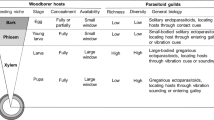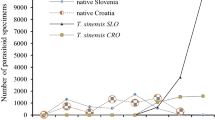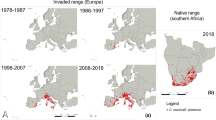Abstract
Since its accidental introduction to south-east England during the nineteenth century, the invasive Australasian fungivore, Cis bilamellatus, has spread across England, Wales and Southern Scotland. Recently it has been recorded from Ireland, the Channel Islands and north-west France. On mainland Britain, an establishment phase spanning an estimated maximum of 45 years was followed by biphasic range expansion comprising a slow start of 1.6 km year−1 between 1910 and 1930, followed by 40 years of approximately linear spread of 13 km year−1. Northwards expansion now appears to be limited by sub-zero winter temperatures and is no longer apparent. Comparison with historic records of native ciids shows that this range expansion is genuine, rather than an artefact of recording effort or bias. It has no doubt been facilitated by C. bilamellatus’ ability to exploit a wide range of sometimes under-used fungal resources, by its favourable rate of increase, by its tolerance of both wet and dry conditions, and by a low rate of parasitoid attack. Although there is the potential for direct and indirect interaction between C. bilamellatus, native ciids and their shared parasitoids, the current ecological impact of C. bilamellatus appears to be low. It seems likely that C. bilamellatus will spread through Europe, limited primarily by resource availability and low winter temperatures.




Similar content being viewed by others
References
Abrams PA, Matsuda H (1996) Positive indirect effects between prey species that share predators. Ecology 77:610–616. doi:10.2307/2265634
Amarasekare P (2002) Interference competition and species coexistence. Proc R Soc Lond B Biol Sci 269:2541–2550. doi:10.1098/rspb.2002.2181
Anderson R, Humphreys I (2006) Leistus rufomarginatus (Duftschmid) (Carabidae) new to Ireland. Coleopterist 15:133
Andow DA, Kareiva PM, Levin SA, Okubo A (1993) Spread of invading organisms: patterns of spread. In: Kim KC, McPheron BA (eds) Evolution of insect pests: patterns of variation. Wiley, New York
Askew RR (1968) Hymenoptera: Chalcidoidea (contd). Handbk Ident Br Insects 8(2b):1–39
Ball SG (1994) The invertebrate site register—objectives and achievements. Br J Ent Nat Hist 7(Suppl 1):2–14
Barber AD, Keay AN (1988) Provisional atlas of the centipedes of the British Isles. Institute of Terrestrial Ecology, Grange-over-Sands
Barney JN, Whitlow TH (2008) A unifying framework for biological invasions: the state factor model. Biol Invasions 10:259–272. doi:10.1007/s10530-007-9127-8
Bridle JR, Vines TH (2007) Limits to evolution at range margins: when and why does adaptation fail? Trends Ecol Evol 22:140–147. doi:10.1016/j.tree.2006.11.002
Burnett J, Copp C, Harding P (1994) Biological recording in the United Kingdom: present practice and future development, vol 1, report. Department of the Environment
Byers JA (2000) Wind-aided dispersal of simulated bark beetles flying through forests. Ecol Model 125:231–243. doi:10.1016/S0304-3800(99)00187-8
Carey JR (1991) Establishment of the Mediterranean fruit fly in California. Science 253:1369–1373. doi:10.1126/science.1896848
Compton SG (2002) Sailing with the wind: dispersal by small flying insects. In: Bullock JM, Kenward RE, Hails RS (eds) Dispersal ecology. 42nd symposium of the British Ecological Society, University of Reading. Blackwell, Oxford, April 2001
Cox ML (2007) Atlas of the seed and leaf beetles of Britain and Ireland. Pisces Publications, Newbury
Crawley MJ (1986) The population biology of invaders. Philos Trans R Soc Lond B Biol Sci 314:711–731. doi:10.1098/rstb.1986.0082
Crawley MJ (1989) Chance and timing in biological invasions. In: Drake JA, Mooney HA et al (eds) Biological invasions: a global perspective. Wiley, New York
Crowson RA (1964) Additional records of Coleoptera from Scottish oak–wood sites. Glasg Nat 18:371–375
Dandy JE (1969) Watsonian vice-counties of Great Britain. Ray Society, London
Elton CS (1958) The ecology of invasions by animals and plants. Methuen, London
Enserink M (1999) Predicting invasions: biological invaders sweep in. Science 285:1834–1836. doi:10.1126/science.285.5435.1834
Entwistle HM (1955) The biology and morphology of the fungus beetles of the family Cisidae and their parasites. MSc thesis, University of London
Ferris R, Bainbridge I (2005) Strategy for non-native species research. UK Biodiversity Research Advisory Group. http://www.jncc.gov.uk/page-4014. Accessed 3 Mar 2008
Gaston KJ (2003) The structure and dynamics of geographic ranges. Oxford University Press, Oxford
Genovisi P, Shine C (2003) European strategy on invasive alien species, final version. UK Biodiversity Research Advisory Group. http://www.jncc.gov.uk/page-4013. Accessed 3 Mar 2008
Guevara R, Rayner ADM, Reynolds SE (2000a) Orientation of specialist and generalist fungivorous ciid beetles to host and non-host odours. Physiol Entomol 25:288–295. doi:10.1046/j.1365-3032.2000.00194.x
Guevara R, Rayner ADM, Reynolds SE (2000b) Effects of fungivory by two specialist ciid beetles (Octotemnus glabriculus and Cis boleti) on the reproductive fitness of their host fungus, Coriolus versicolor. New Phytol 145:137–144. doi:10.1046/j.1469-8137.2000.00552.x
Hammond PM (1974) Changes in the British coleopterous fauna. In: Hawksworth DL (ed) The changing flora and fauna of Britian. Systematics Association special volume 6. Academic Press, London
Harding PT, Sheail J (1992) The Biological Records Centre: a pioneer in data gathering and retrieval. In: Harding PT (ed) Biological recording of changes in British wildlife. HMSO, London
Hastings A, Cuddington K, Dugaw CJ, Elmendorf S, Freestone A, Harrison S, Holland M, Lambrinos J, Malvadkar U, Melbourne BA, Moore K, Taylor C, Thomson D (2005) The spatial spread of invasions: new developments in theory and evidence. Ecol Lett 8:91–101. doi:10.1111/j.1461-0248.2004.00687.x
Hayes KR, Barry SC (2008) Are there any consistent predictors of invasion success? Biol Invasions 10:483–506. doi:10.1007/s10530-007-9146-5
Holt RD (1977) Predation, apparent competition, and the structure of prey communities. Theor Popul Biol 12:197–228. doi:10.1016/0040-5809(77)90042-9
Holt RD, Lawton JH (1994) The ecological consequences of shared enemies. Annu Rev Ecol Syst 25:495–520. doi:10.1146/annurev.es.25.110194.002431
Jelínek J (2007) Nomenclatural changes in the family Ciidae (Coleoptera). Acta Entomologica Musei Nationalis Pragae 47:135–141
Jelínek J (2008) Ciidae. In: Löbl I, Smetana A (eds) Catalogue of Palaearctic Coleoptera vol 5. Apollo Books, Stenstrup
Johnson CG (1967) International dispersal of insects and insect-borne viruses. Neth J Pl Path 73(Supp 1):21–43. doi:10.1007/BF01974421
Johnson LE, Carlton JT (1996) Post-establishment spread in large-scale invasions: dispersal mechanisms of the zebra mussel Creissena polymorpha. Ecology 77:1686–1690. doi:10.2307/2265774
Jonsell M, Nordlander G (2004) Host selection patterns in insects breeding in bracket fungi. Ecol Entomol 29:697–705. doi:10.1111/j.0307-6946.2004.00654.x
Jonsell M, Nordlander G, Ehnström B (2001) Substrate associations of insects breeding in fruiting bodies of wood-decay fungi. Ecol Bull 49:173–194
Kirk WDJ, Terry LI (2003) The spread of the western flower thrips Frankliniella occidentalis (Pergande). Agric For Entomol 5:301–310. doi:10.1046/j.1461-9563.2003.00192.x
Kirkendall LR, Ødegaard F (2007) Ongoing invasions of old-growth tropical forests: establishment of three incestuous beetle species in southern Central America (Curculionidae:Scolytinae). Zootaxa 1588:53–62
Kolar CS, Lodge DM (2001) Progress in invasion biology: predicting invaders. Trends Ecol Evol 16:199–204. doi:10.1016/S0169-5347(01)02101-2
Komonen A (2001) Structure of insect communities inhabiting old-growth forest specialist bracket fungi. Ecol Entomol 26:63–75. doi:10.1046/j.1365-2311.2001.00295.x
Lawrence JF (1967) Delimitation of the genus Ceracis (Coleoptera: Ciidae) with a revision of North American species. Bull Mus Comp Zool 136:91–144
Lawrence JF (1973) Host preference in ciid beetles (Coleoptera: Ciidae) inhabiting the fruiting bodies of basidiomycetes in North America. Bull Mus Comp Zool 145:163–212
Legon NW, Henrici A (2005) Checklist of the British and Irish Basidiomycota. Royal Botanic Gardens Kew, Richmond
Liebhold AM, Halverson JA, Elmes GA (1992) Gypsy moth invasion in North America: a quantitative analysis. J Biogeogr 19:513–520. doi:10.2307/2845770
Lockwood JL, Hoopes MF, Marchetti MP (2007) Invasion ecology. Blackwell, Oxford
Lohse GA, Reibnitz J (1991) Cis multidentatus (Pic), ein unbeachteter Vorratsschädling (Coleoptera. Cisidae). Acta Coleopterol 7:103–105
Lopes-Andrade C (2008) The first record of Cis chinensis Lawrence from Brazil, with the delimitation of the Cis multidentatus species-group (Coleoptera: Ciidae). Zootaxa 1755:35–46
Mack RN, Simberloff D, Lonsdale WM, Evans H, Clout M, Bazzaz F (2000) Biotic invasions: causes, epidemiology, global consequences, and control. Ecol Appl 10:689–710. doi:10.1890/1051-0761(2000)010[0689:BICEGC]2.0.CO;2
Majerus M, Strawson V, Roy H (2006) The potential impacts of the arrival of the harlequin ladybird, Harmonia axyridis (Pallas) (Coleoptera: Coccinellidae), in Britain. Ecol Entomol 31:207–215. doi:10.1111/j.1365-2311.2006.00734.x
Manchester SJ, Bullock JM (2000) The impacts of non-native species on UK biodiversity and the effectiveness of control. J Appl Ecol 37:845–864. doi:10.1046/j.1365-2664.2000.00538.x
Moles AT, Gruber MAM, Bonser SP (2008) A new framework for predicting invasive plant species. J Ecol 96:13–17
Muirhead JR, Leung B, van Overdijk C, Kelly DW, Nandakumar K, Marchant KR, MacIsaac HJ (2006) Modelling local and long-distance dispersal of invasive emerald ash borer Agrilus planipennis (Coleoptera) in North America. Divers Distrib 12:71–79. doi:10.1111/j.1366-9516.2006.00218.x
Neubert MG, Caswell H (2000) Demography and dispersal: calculation and sensitivity analysis of invasion speed for structured populations. Ecology 81:1613–1628
Orledge GM (1997) Putting the Ciidae on the map. Coleopterist 6:79
Orledge GM, Booth RG (2006) An annotated checklist of British and Irish Ciidae with revisionary notes. Coleopterist 15:1–16
Orledge GM, Reynolds SE (2005) Fungivore host-use groups from cluster analysis: patterns of utilisation of fungal fruiting bodies by ciid beetles. Ecol Entomol 30:620–641. doi:10.1111/j.0307-6946.2005.00727.x
Owen JA (1983) Surplus beetles. Antenna 7:100
Parker IM, Simberloff D, Lonsdale WM, Goodell K, Wonham M, Kareiva PM, Williamson MH, Von Holle B, Moyle PB, Byers JE, Goldwasser L (1999) Impact: toward a framework for understanding the ecological effects of invaders. Biol Invasions 1:3–19. doi:10.1023/A:1010034312781
Paviour-Smith K (1960a) The invasion of Britain by Cis bilamellatus Fowler (Coleoptera: Ciidae). Proc R Ent Soc Lond A 35:145–155
Paviour-Smith K (1960b) The fruiting bodies of macrofungi as habitats for beetles of the family Ciidae (Coleoptera). Oikos 11:43–71. doi:10.2307/3564883
Paviour-Smith K (1967) A ‘summer’ development time for Cis bilamellatus Wood (Col., Ciidae). Ent mon Mag 103:247–249
Paviour-Smith K (1968a) A population study of Cis bilamellatus Wood (Coleoptera, Ciidae). J Anim Ecol 37:205–228. doi:10.2307/2720
Paviour-Smith K (1968b) Mortality in Cis bilamellatus Wood (Col., Ciidae) in the severe British winter of 1962–63. Ent mon Mag 104:233–236
Pérez JE, Nirchio M, Alfonsi C, Muños C (2006) The biology of invasions: the genetic adaptation paradox. Biol Invasions 8:1115–1121. doi:10.1007/s10530-005-8281-0
Perkins JF (1976) Hymenoptera: Bethyloidea (excluding Chrysididae). Handbk Ident Br Insects 6(3a):1–38
Pielou DP, Verma AN (1968) The arthropod fauna associated with the birch bracket fungus, Piptoporus betulinus, in eastern Canada. Can Entomol 100:1179–1199
Quinn RM, Gaston KJ, Arnold HR (1996) Relative measures of geographic range size: empirical comparisons. Oecologia 107:179–188. doi:10.1007/BF00327901
Rapoport EH (2000) Remarks on the biology of land invasions. Rev Chil Hist Nat 73:367–380
Reibnitz J (1999) Verbreitung und Lebensräume der Baumschwammfresser Südwestdeutschlands (Coleoptera; Cisidae). Mitt ent V Stuttgart 34:1–76
Ricciardi A, Cohen J (2007) The invasiveness of an introduced species does not predict its impact. Biol Invasions 9:309–315. doi:10.1007/s10530-006-9034-4
Richards OW (1939) The British Bethylidae (S.L.) (Hymenoptera). Trans R Ent Soc Lond 89:185–344
Richardson DM, Pyšek P, Rejmánek M, Barbour MG, Panetta FD, West CJ (2000) Naturalization and invasion of alien plants: concepts and definitions. Divers Distrib 6:93–107. doi:10.1046/j.1472-4642.2000.00083.x
Roy H, Wajnberg E (eds) (2008) From biological control to invasion: the ladybird Harmonia axyridis as a model species. BioControl 53:1–287. doi: 10.1007/s10526-007-9127-8
Sakai AK, Allendorf FW, Holt JS, Lodge DM, Molofsky J, With KA, Baughman S, Cabin RJ, Cohen JE, Ellstrand NC, McCauley DE, O’Neil P, Parker IM, Thompson JN, Weller SG (2001) The population biology of invasive species. Annu Rev Ecol Syst 32:305–332. doi:10.1146/annurev.ecolsys.32.081501.114037
Shea K, Chesson P (2002) Community ecology theory as a framework for biological invasions. Trends Ecol Evol 17:170–176. doi:10.1016/S0169-5347(02)02495-3
Shigesada N, Kawasaki K (1997) Biological invasions: theory and practice. Oxford University Press, Oxford
Shigesada N, Kawasaki K, Takeda Y (1995) Modeling stratified diffusion in biological invasions. Am Nat 146:229–251. doi:10.1086/285796
Shorrocks B, Bingley M (1994) Priority effects and species coexistence: experiments with fungal-breeding Drosophila. J Anim Ecol 63:799–806. doi:10.2307/5257
Simberloff D (1989) Which insect introductions succeed and which fail? In: Drake JA, Mooney HA et al (eds) Biological invasions: a global perspective. Wiley, New York
Speight MR, Hunter MD, Watt AD (1999) Ecology of insects: concepts and applications. Blackwell, Oxford
Stokes K, O’Neill K, McDonald R (2004) Invasive species in Ireland. UK Biodiversity Research Advisory Group. http://www.jncc.gov.uk/page-4015. Accessed 3 Mar 2008
Taylor LR (1974) Insect migration, flight periodicity and the boundary layer. J Anim Ecol 43:225–238. doi:10.2307/3169
Thunes KH (1994) The coleopteran fauna of Piptoporus betulinus and Fomes fomentarius (Aphyllophorales: Polyporaceae) in western Norway. Entomol Fenn 5:157–168
Twinn PFG, Harding PT (1999) Provisional atlas of the longhorn beetles (Coleoptera, Cerambycidae) of Britain. Biological Records Centre, Huntingdon
Valéry L, Fritz H, LeFeuvre J-C, Simberloff D (2008) In search of a real definition of the biological invasion phenomenon itself. Biol Invasions 10:1345–1351. doi:10.1007/s10530-007-9209-7
van Veen FJF, Morris RJ, Godfray HCJ (2006) Apparent competition, quantitative food webs, and the structure of phytophagous insect communities. Annu Rev Entomol 51:187–208. doi:10.1146/annurev.ento.51.110104.151120
Williamson M (1996) Biological invasions. Chapman and Hall, London
Williamson M (1999) Invasions. Ecography 22:5–12. doi:10.1111/j.1600-0587.1999.tb00449.x
Williamson M, Brown KC (1986) The analysis and modelling of British invasions. Philos Trans R Soc Lond B Biol Sci 314:505–522. doi:10.1098/rstb.1986.0070
Wood T (1884) A new species of Cis. Ent mon Mag 21:130–131
Yan Z, Sun J, Don O, Zhang Z (2005) The red turpentine beetle, Dendroctonus valens LeConte (Scolytidae): an exotic invasive pest of pine in China. Biodivers Conserv 14:1735–1760. doi:10.1007/s10531-004-0697-9
Acknowledgments
Our grateful thanks to all those who have generously contributed personal and collated ciid records used in this study, to museum and society trustees and staff for permitting and facilitating access to the collections in their care, and to Roy Anderson and Boris Büche for permission to use their unpublished first records of C. bilamellatus from Northern Ireland and France, respectively. We thank Mark Shaw and Richard Askew for parasitoid determinations, Mark Telfer for providing British records of Leistus rufomarginatus, Colin Johnson for ciid pin data from the Manchester Museum collection, John Lawrence for helpful correspondence and the Royal Entomological Society librarian, Val McAtear, for help with accessing the literature. We are grateful to Daniel Simberloff and two anonymous reviewers for their valuable comments on this manuscript. Maps were prepared using A. J. Morton’s DMAP software. Travel expenses for museum visits were met by a grant to GMO from the British Entomological and Natural History Society Research Fund.
Author information
Authors and Affiliations
Corresponding author
Appendix
Rights and permissions
About this article
Cite this article
Orledge, G.M., Smith, P.A. & Reynolds, S.E. The non-pest Australasian fungivore Cis bilamellatus Wood (Coleoptera: Ciidae) in northern Europe: spread dynamics, invasion success and ecological impact. Biol Invasions 12, 515–530 (2010). https://doi.org/10.1007/s10530-009-9455-y
Received:
Accepted:
Published:
Issue Date:
DOI: https://doi.org/10.1007/s10530-009-9455-y




